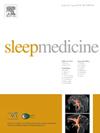凯罗斯气道正压(KPAP)的效果与持续气道正压相同,为阻塞性睡眠呼吸暂停的治疗提供卓越的舒适性
IF 3.8
2区 医学
Q1 CLINICAL NEUROLOGY
引用次数: 0
摘要
研究目的最近的一项研究对维持吸气气道正压 (IPAP) 是上气道通畅所必需的这一普遍临床观点提出了质疑,研究结果表明,在使用和不使用电阻器降低 IPAP 的连续气道正压 (CPAP) 之间,呼吸暂停低通气指数 (AHI) 没有差异。在本研究中,我们评估了 Kairos PAP (KPAP) 对睡眠呼吸暂停严重程度和主观舒适度的影响。在 "疗效 "试验中,采用分夜设计考察了 KPAP 与 CPAP 对经 PAP 治疗的 OSA 患者 AHI 的影响,并对仰卧睡眠的时间、顺序和比例进行了调整(混合模型)。此外,还研究了不同治疗方法之间的无意泄漏差异。探索性分析评估了 KPAP 与 CPAP 对主要多导睡眠图结果的影响。在舒适度试验中,我们测试了 PAP 不适用的 OSA 患者对 KPAP 与 CPAP 在 9 和 13 cmH2O 条件下的主观偏好。无意泄漏也减少了 50% 以上(-2.5 [-3.2, -1.7] L/min,P = 0.001)。在所评估的探索性变量中未观察到明显变化。在舒适度试验(N = 150)中,分别有 69 [61, 77] % 和 84 [77, 89] % 的参与者更喜欢 KPAP 而不是 9 和 13 cmH2O 的 CPAP(P < 0.001)。本文章由计算机程序翻译,如有差异,请以英文原文为准。
Kairos positive airway pressure (KPAP) equals continuous PAP in effectiveness, and offers superior comfort for obstructive sleep apnea treatment
Study objectives
A recent study challenged the prevailing clinical view that maintaining inspiratory positive airway pressure (IPAP) is necessary for upper airway patency, demonstrating no differences in apnea hypopnea index (AHI) between continuous PAP (CPAP) with and without a resistor to reduce IPAP. In this study, we assessed the effect of Kairos PAP (KPAP), a new algorithm which features multiple drops in IPAP, only returning to therapeutic pressure near the end expiration, on sleep apnea severity and subjective comfort.
Methods
Two randomized clinical trials were conducted. In the Efficacy trial, the effect of KPAP vs. CPAP on AHI in PAP-treated OSA patients was examined using a split-night design, adjusting for period, sequence and fraction of supine sleep (mixed models). Unintentional leak differences between treatments were also examined. Exploratory analyses assessed the effect of KPAP vs. CPAP on key polysomnography outcomes. In the Comfort trial, we tested subjective preference for KPAP vs. CPAP at 9 and 13 cmH2O in PAP-naïve OSA patients.
Results
In the Efficacy trial (N = 48), KPAP reduced AHI more than CPAP (mean difference [95%CI]: −0.5 [−0.8, −0.2] events/h, P = 0.007). Unintentional leak was also reduced by over 50 % (−2.5 [−3.2, −1.7] L/min, P < 0.001). No significant change was observed in the exploratory variables assessed. In the Comfort trial (N = 150), 69 [61, 77] % and 84 [77, 89] % of participants preferred KPAP over CPAP at 9 and 13 cmH2O, respectively (P < 0.001).
Conclusions
KPAP is as effective as CPAP in reducing respiratory events, but is more comfortable and potentially better tolerated.
求助全文
通过发布文献求助,成功后即可免费获取论文全文。
去求助
来源期刊

Sleep medicine
医学-临床神经学
CiteScore
8.40
自引率
6.20%
发文量
1060
审稿时长
49 days
期刊介绍:
Sleep Medicine aims to be a journal no one involved in clinical sleep medicine can do without.
A journal primarily focussing on the human aspects of sleep, integrating the various disciplines that are involved in sleep medicine: neurology, clinical neurophysiology, internal medicine (particularly pulmonology and cardiology), psychology, psychiatry, sleep technology, pediatrics, neurosurgery, otorhinolaryngology, and dentistry.
The journal publishes the following types of articles: Reviews (also intended as a way to bridge the gap between basic sleep research and clinical relevance); Original Research Articles; Full-length articles; Brief communications; Controversies; Case reports; Letters to the Editor; Journal search and commentaries; Book reviews; Meeting announcements; Listing of relevant organisations plus web sites.
 求助内容:
求助内容: 应助结果提醒方式:
应助结果提醒方式:


